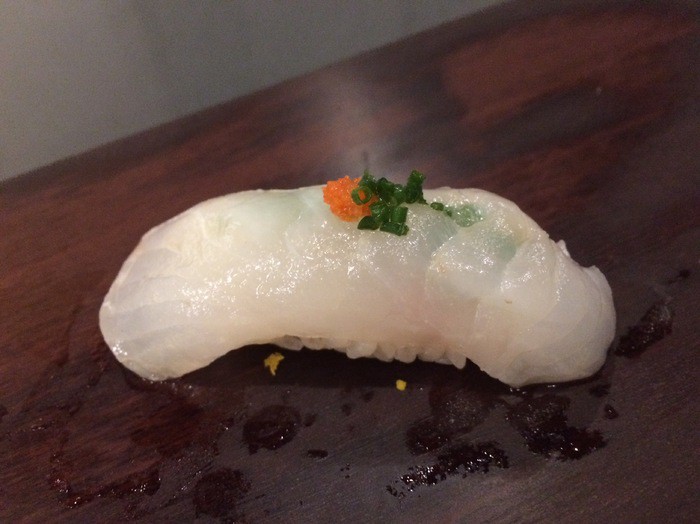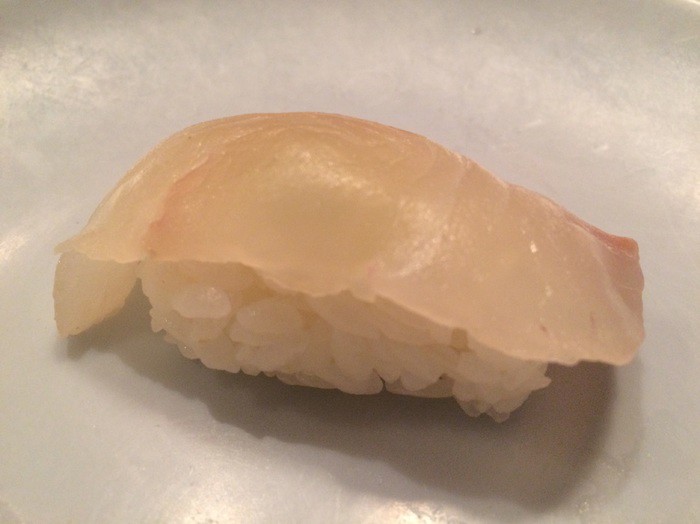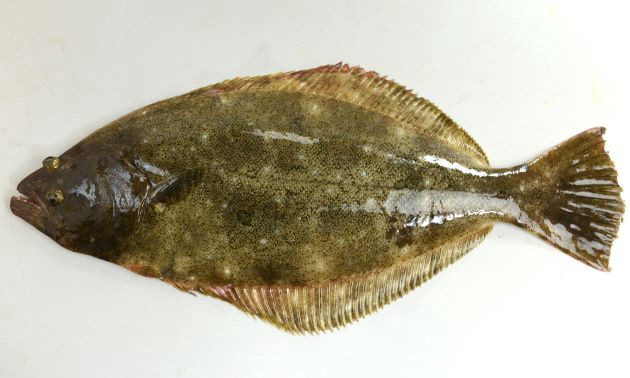 Hirame topped with chives
Hirame topped with chives
Hirame (??) is a common nigiri you can find at many sushi restaurants. It?s a white fish with a mild flavor compared to other pieces you would find on the menu. The texture is soft and chewy, and slightly pink in color or dark grey veins that reminds one of faint watercolors on a canvas.
The best season to eat hirame is autumn to winter. Due to the mild flavor, it?s typically used as a balance against the other oiler and more fragrant fish. A competent chefs can use hirame as a base canvas to paint other flavors on top. The chef can eschew soy sauce, and instead use a citrus yuzu or sea salt. And if you can find it, the chef might marinate it in kelp to infuse it with a surprising umami flavor.
When you order hirame at a sushi restaurant, you?ll often see white flesh with shades of pink as subtle accents. At other times, you?ll see more greyish flesh with dark veins prominently showing. Don?t be alarmed! These are from the same fish, but different cuts. The filet facing down towards the ocean bottom is the the one that is pink, and the filet facing up towards the sun is the one that?s veined.
 Bottom side hirame
Bottom side hirame Top side hirame
Top side hirame
What kind of fish is hirame?
Like the tuna, there is actually another nigiri sushi piece with an entirely different texture and taste called Engawa cut from the same fish. We?ll cover that piece next time, but the current mystery is: what kind of fish is hirame? On most sushi menus, it will translate it as flounder. At other times, you?ll see fluke or halibut. Which is it?
 Japanese flounder (Paralichthys olivaceus)
Japanese flounder (Paralichthys olivaceus)
According to zukan-bouz, the hirame is the Japanese flounder / Olive flounder / Bastard halibut. However, given that it?s only found in the shallower waters around Japan and China, I wouldn?t be surprised if the sushi shops in the US substitute it with the flounders found on the Atlantic coast of North America instead. This is where you find fishes commonly known as flukes and founders.
Flounders and flukes are both flatfishes. If you grew up with Disney, you might have thought flounders were pudgy round yellow and blue-striped fish that was a sea-bound hero?s best sidekick until the Blue Tang came along.
In actuality, despite a constitution like a common fish, it swims horizontally, with one side of its body on the bottom of ocean floor. The top side of a flat fish is dark and patterned making them blend well into the ocean bottoms, whereas the bottom side tends to be blindingly white. It?s like they only tanned one side of their body for life.
A flatfish is actually born swimming vertically with eyes on both sides of its body. But so committed is it to swimming flat, one of its eyes moves to the other side as it matures. This results in an unfortunate countenance and anatomical disaster only a mother could love. It?s as if evolution gleefully played with it like pre-school clay and the parents kept it for ?sentimental value?. It?s a weird evolutionary quirk that had Charles Darwin puzzled about. If that wasn?t odd enough, flounders can change their skin color to camouflage themselves on the ocean floor, like cuttlefish and octopuses do.
 This is a flounder
This is a flounder
All flukes are flounders, but not all flounders are flukes
As for the difference between Flounders and Flukes, the confusion come from Flounder being used as a general term for flatfish. All flukes are flounders, but not all flounders are flukes.
Common to the Atlantic coast, there is the Winter Flounder, the Summer Flounder, and the Yellowtail Flounder. The Winter Flounder (commonly called flounder) comes into the continental shelf in the winter when it?s caught. The Summer Flounder (commonly called fluke) comes into the continental shelf in the summer when it?s caught. There are other two flatfish that are also flounders, called the American Plaice and the Atlantic Halibut, but neither have flounder in its name.
But the easiest way to tell the difference between flounders and flukes is to look at which side of the fish, both eyes are on. The Winter Flounder (flounder) has its eyes on the right side and small mouths, whereas the Summer Flounder (fluke) has its eyes on the left side and large toothy mouths.
Though distantly related, I?d be hard pressed to be able to taste the difference between the two, though I?ve heard flukes to be described as a bit ?muddier? in taste.
As for the Halibut, it is also a type of right-eyed flatfish, but is in a different genus than the flounder or the fluke. They?re much bigger, growing to about a couple hundred pounds. Technically, the japanese term for hailbut is ohyou (??).
Things to remember
Hirame is technically the Japanese flounder. But they might be substituted by Atlantic species, like the Winter and Summer flounders.
Winter flounders are right side up, and generally called flounders. While Summer flounders are left side up, and called fluke. The Japanese don?t call halibut hirame, but instead, ohyou.
And hirame meat can be either white with pink accents or grey with dark veins depending on which side of the filet it?s cut from!

References
- https://www.reluctantgourmet.com/fluke-or-flounder-what-is-the-difference/
- https://animalsake.com/difference-between-fluke-flounder
- http://www.zukan-bouz.com/syu/%E3%83%92%E3%83%A9%E3%83%A1
- http://www.fishbase.se/summary/Paralichthys-olivaceus.html
- http://fishbase.org/summary/Paralichthys-dentatus.html


